Boab Prison Tree, Derby facts for kids
The Boab Prison Tree, Derby is a very old and large boab tree located about 6 kilometres south of Derby, Western Australia. This amazing tree is around 1,500 years old! Its trunk is huge, measuring about 14.7 metres around. For a long time, people believed this hollow tree was used as a temporary jail for Aboriginal prisoners in the 1890s, who were being taken to Derby for legal reasons. However, there is no real proof that it was ever used to hold prisoners.
The Boab Tree's Ancient Uses
In the Nyulnyulan languages spoken by the Aboriginal people of the Western Kimberley region, boab trees are called 'larrgadiy'. These trees are very important in their traditional stories and beliefs. Many ancient boab trees are seen as special living beings with their own unique personalities.
An early European explorer named Herbert Basedow was one of the first to write about the Derby Boab Tree. In 1916, he took a picture of it and wrote that Aboriginal people used the hollow trunk as a shelter or even a burial place. He mentioned finding human bones inside, which suggests it was sometimes used to keep the remains of the dead. Basedow also said the tree was a "dry and comfortable hut" for the local people. The bones he saw are no longer there, and they might have been taken.
The 'Prison Tree' Story
The idea that this boab tree was a "prison tree" started much later, around 1948. Two researchers, Kristyn Harman and Elizabeth Grant, looked into how this story began. They found that an Australian artist named Vlase Zanalis stayed near Derby and was very interested in the boab trees. When one of his paintings of the tree was shown, a newspaper article claimed the tree's trunk had been used as a temporary prison.
Harman and Grant discovered that the story of a prison tree actually belonged to a different boab tree in Wyndham. Over time, this story got mixed up and was mistakenly told about the Derby tree. Even though there's no historical evidence to support it, the myth became widely believed. Another expert, Kim Akerman, also said the story wasn't true. He explained that Aboriginal traditional stories do not mention the tree being used to imprison people, either by the police or by others.
The Tree Today
Today, the Boab Prison Tree is a popular place for tourists to visit. It is protected by the Aboriginal Heritage Act 1972, which helps preserve important Aboriginal sites.
To keep the tree safe from damage, a fence was put up around it in recent years. This helps protect it from too many people walking near it, carving their names into its trunk, and from vehicles compacting the soil around its roots.



